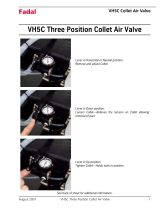
SLICE EXOTHERMIC CUTTING EQUIPMENT
3
89250845
Ventilation must be adequate to remove smoke, fumes, and gases during operation to
protect operators and others in the area. Vapors of chlorinated solvents can form the
toxic gas "Phosgene" when exposed to ultraviolet radiation from an electric arc. All
solvents, degreasers, and potential sources of these vapors must be removed from the
operating area. Use air-supplied respirators if ventilation is not adequate to remove all
fumes and gases. Oxygen supports, and vigorously accelerates fire and should never be used for
ventilation. See safety and operating references 1, 2, 3, and 4.
ARC RAYS, HOT SLAG, AND SPARKS CAN INJURE EYES AND BURN SKIN
Welding and cutting processes produce extreme localized heat and strong ultraviolet
rays. Never attempt to weld/cut without a federally compliant welding helmet with the
proper lens. A number 12 to 14 shade filter lens provides the best protection against
arc radiation. When in a confined area, prevent the reflected arc rays from entering
around the helmet. Approved shielding curtains and appropriate goggles should be used
to provide protection to others in the surrounding area. Skin should be protected from arc rays, heat,
and molten metal. Always wear protective gloves and clothing. All pockets should be closed and cuffs
sewn shut. Leather aprons, sleeves, leggings, etc. should be worn for out-of-position welding and cutting,
or for heavy operations using large electrodes. Hightop work shoes provide adequate protection from
foot burns. For added protection, use leather spats. Flammable hair preparations should not be used
when welding/cutting. Wear ear plugs to protect ears from sparks. Where work permits, the operator
should be enclosed in an individual booth painted with a low reflective material such as zinc oxide. See
safety and operating references 1, 2, and 3.
WELDING SPARKS CAN CAUSE FIRES AND EXPLOSIONS
Combustibles reached by the arc, flame, flying sparks, hot slag, and heated materials
can cause fire and explosions. Remove combustibles from the work area and/or provide
a fire watch. Avoid oily or greasy clothing as a spark may ignite them. Have a fire
extinguisher nearby, and know how to use it. If welding/cutting is to be done on a metal
wall, partition, ceiling, or roof, precautions must be taken to prevent ignition of nearby
combustibles on the other side. Do not weld/cut containers that have held combustibles.
All hollow spaces, cavities, and containers should be vented prior to welding/cutting to permit the escape
of air or gases. Purging with inert gas is recommended. Never use oxygen in a welding torch. Use only
inert gases or inert gas mixes as required by the process. Use of combustible compressed gases can
cause explosions resulting in personal injury or death. Arcing against any compressed gas cylinder can
cause cylinder damage or explosion. See safety and operating references 1, 2, 5, 7, and 8.
NOISE CAN DAMAGE HEARING
Noise from the air carbon-arc process can damage your hearing. Wear protective hearing
devices to ensure protection when noise levels exceed OHSA standards. Adequate hearing
protection devices must be worn by operators and surrounding personnel to ensure personal
protection against noise. See safety and operating references 1, 2, and 6.
Safety Precautions


























